Why Xishuangbanna Should Be Your Next Travel Destination in China
Contents
- How to Get to Xishuangbanna
- Why Xishuangbanna Feels Like Thailand
- Shared Cultural Roots of the Dai and Thai Peoples
- The Water-Splashing Festival vs. Songkran
- Culinary Parallels
- Top 20 Things to Do in Xishuangbanna
- 1. Spot Wild Elephants in Wild Elephant Valley
- 2. Explore Xishuangbanna Tropical Botanical Garden
- 3. Wander Manting Park’s Historic Gardens
- 4. Immerse in Xishuangbanna Dai Garden
- 5. Visit Mengle Dafo Buddhist Temple
- 6. Savor Dai Cuisine at Gaozhuang Night Market
- 7. Discover Ancient Dai Temples in Jingzhen and Damenglong
- 8. Experience Xishuangbanna Primeval Forest Park
- 9. Walk the Wangtianshu Canopy in Mengla
- 10. Taste Pu’er Tea at UNESCO-Listed Jingmai Mountain
- 11. Join the Water-Splashing Festival Fun
- 12. Visit Hani and Jinuo Ethnic Villages
- 13. Enjoy a Dai Cultural Show
- 14. Cycle Rural Mengla Trails
- 15. Kayak or Raft on the Lancang (Mekong) River
- 16. Explore Jinghong’s Tropical Flower & Plants Garden
- 17. Take a Cross-Border Train to Laos
- 18. Hike the Jinuo Mountain Rainforest
- 19. Experience a Hot Air Balloon Flight over the Tropical Botanical Garden
- 20. Visit White Elephant Beach Park
- Practical Travel Tips for Visiting Xishuangbanna
- Best Time to Visit Xishuangbanna
- Getting Around in Xishuangbanna
Show more
Nestled in the southernmost corner of Yunnan Province, where China borders Laos and Myanmar, Xishuangbanna Dai Autonomous Prefecture is a tropical haven that feels like a world apart from the China you might imagine.
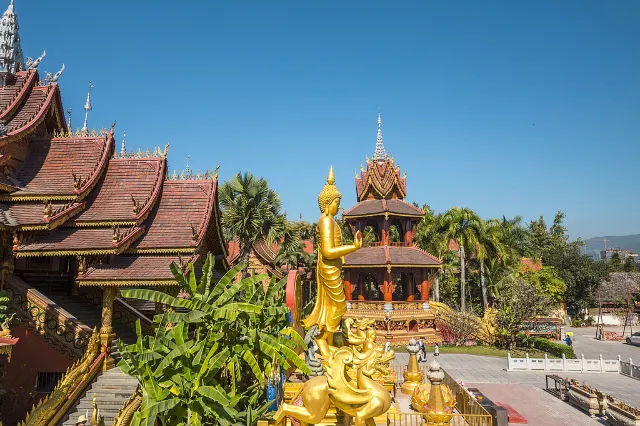
Often hailed as “China’s mini Thailand,” this vibrant region blends the lush rainforests, golden pagodas, and spicy culinary delights of Southeast Asia with the cultural richness of China’s ethnic minorities. For travelers, Xishuangbanna offers an intoxicating escape, where you can wander through tropical jungles, spot wild Asian elephants, and join the Dai people in their exuberant Water-Splashing Festival, a celebration akin to Thailand’s Songkran.
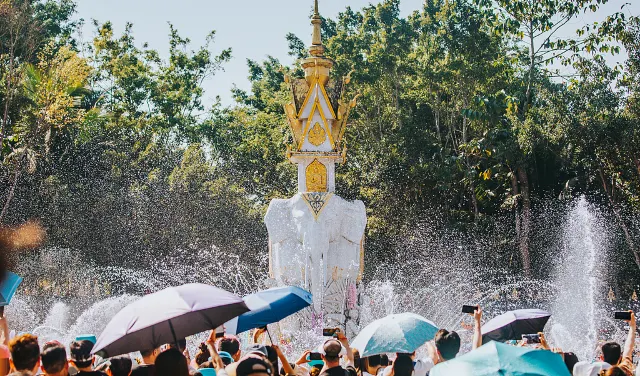
Located just 360 kilometers southwest of Kunming, Yunnan’s capital, and geographically closer to Bangkok than Beijing, Xishuangbanna is a unique fusion of cultures, landscapes, and experiences that belongs on every nature lover’s and culture enthusiast’s bucket list.
Known as the “Kingdom of Animals and Plants,” Xishuangbanna boasts an astonishing biodiversity, with over 13,000 plant species and rare wildlife thriving in its emerald rainforests. The region is home to 13 ethnic groups, with the Dai—cousins to the Thai people—leading the cultural charge with their vibrant festivals, intricate dances, and nature-revering traditions.
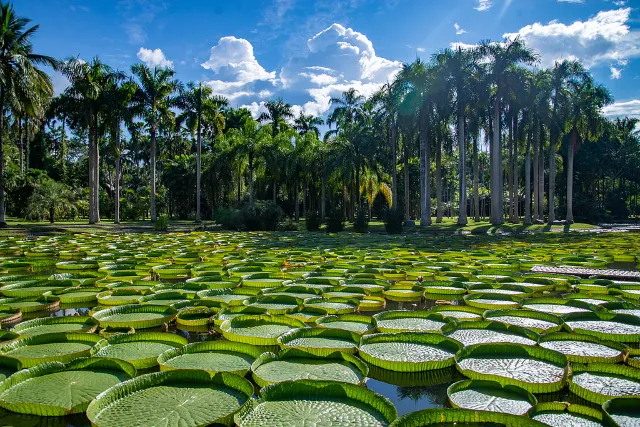
From the bustling night markets of Jinghong, where Dai-style grilled fish and pineapple rice await you, to ancient temples that echo the architecture of Chiang Mai, Xishuangbanna delivers a sensory overload that’s both exotic and accessible.
This Xishuangbanna travel guide will take you through the region’s top attractions, cultural highlights, and practical tips, revealing why this tropical paradise is your next must-visit destination in China. Ready to discover a place where China meets Thailand in a burst of color, flavor, and adventure? Let’s explore.
Reaching Xishuangbanna is remarkably convenient, thanks to its well-connected transport options. Xishuangbanna Gasa International Airport (JHG) in Jinghong, the region’s main hub, welcomes frequent flights from Kunming, Yunnan’s capital, in just about one hour, making it an easy hop for travelers already in China.
You can also find direct flights from other major Chinese cities like Beijing, Shanghai, and Chengdu, offering flexibility for international visitors connecting through these hubs. For those traveling from Southeast Asia, international flights from Chiang Mai and Chiang Rai in Thailand provide a seamless way to enter Xishuangbanna’s tropical region.
Alternatively, high-speed trains from Kunming to Jinghong, covering the 360-kilometer journey in approximately 3–4 hours, offer a scenic and efficient option. These modern trains, part of the China-Laos railway network, also connect to other major cities, such as Chengdu and Guangzhou, making rail travel a comfortable choice for exploring Xishuangbanna.
Whether by air or rail, getting to this tropical paradise is a breeze, setting the stage for an unforgettable adventure.
Xishuangbanna’s nickname, “China’s mini Thailand,” isn’t just clever marketing—it’s a testament to the region’s uncanny resemblance to its Southeast Asian neighbor. Straddling the borders of Myanmar and Laos, Xishuangbanna mirrors Thailand’s tropical landscapes, Buddhist heritage, and festive spirit, offering travelers a unique blend of familiarity and discovery.
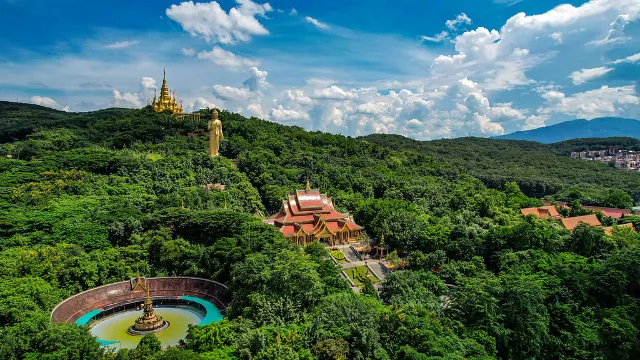
This resemblance stems from the shared cultural roots of the Dai people, Xishuangbanna’s largest ethnic group, and the Thai people, creating a destination that feels like a cross-border journey without leaving China.
From temple architecture to culinary delights, here’s why Xishuangbanna captures the essence of Thailand while remaining distinctly Chinese.
The Dai, who make up a significant portion of Xishuangbanna’s population, are part of the Tai ethnic family, which also includes the Thai people of Thailand. This shared heritage is evident in their language, customs, and reverence for nature.
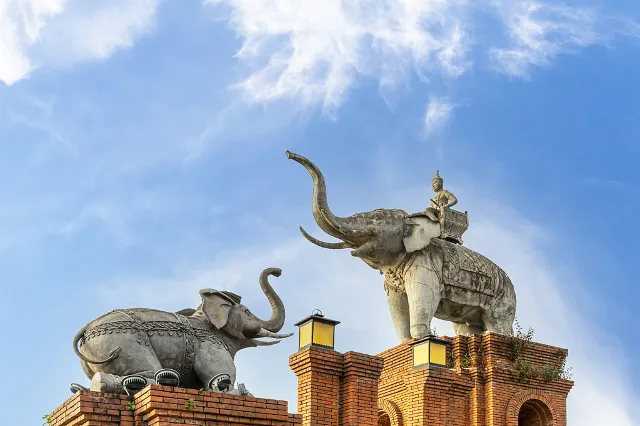
Stroll through Jinghong, Xishuangbanna’s vibrant capital, and you’ll find stilted wooden houses and ornate temples that could easily grace the streets of Chiang Rai or Luang Prabang. Both cultures practice Theravada Buddhism, as reflected in the golden spires and intricate designs of Xishuangbanna’s Mengle Buddhist Temple, which is reminiscent of Thailand’s Wat Phra Kaew.
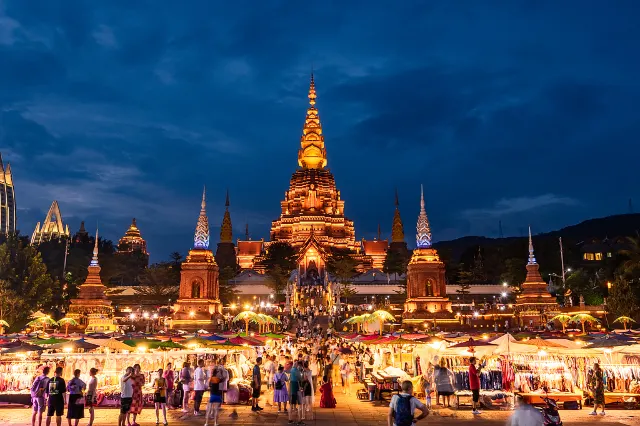
Traditional Dai clothing, with its bright silks and intricate embroidery, mirrors Thai traditional dress, adding a splash of color to festivals and daily life. These parallels make Xishuangbanna a cultural bridge, offering travelers a taste of Thailand’s charm within China’s borders.
Nothing embodies Xishuangbanna’s Thai-like spirit more than the Water-Splashing Festival, held annually in mid-April to mark the Dai New Year. This three-day extravaganza transforms Jinghong into a joyous playground of water fights, where locals and visitors wield squirt guns, buckets, and even hoses to douse each other in a cleansing ritual that symbolizes renewal and good fortune.
Sound familiar?
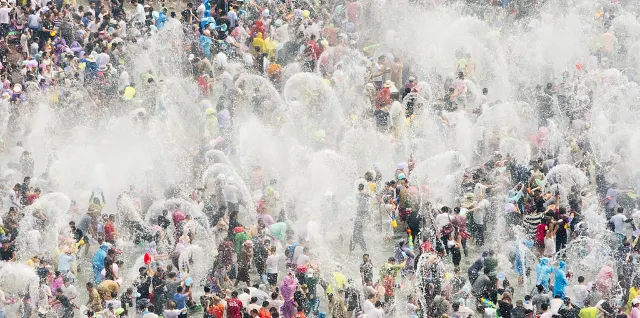
It’s strikingly similar to Thailand’s Songkran festival, which shares the same timing and traditions. Beyond water fights, the festival features dragon boat races on the Lancang (Mekong) River, traditional Dai dances, and vibrant markets, offering an immersive cultural experience. Joining this festival is a bucket-list moment, blending the thrill of participation with a deep dive into Dai culture.
The culinary scene in Xishuangbanna is a delicious fusion of Dai and Thai flavors, making every meal a cross-cultural adventure. Like Thai cuisine, Dai food celebrates bold, spicy notes with staples like sticky rice, lemongrass-infused grilled meats, and tangy herb-based sauces.
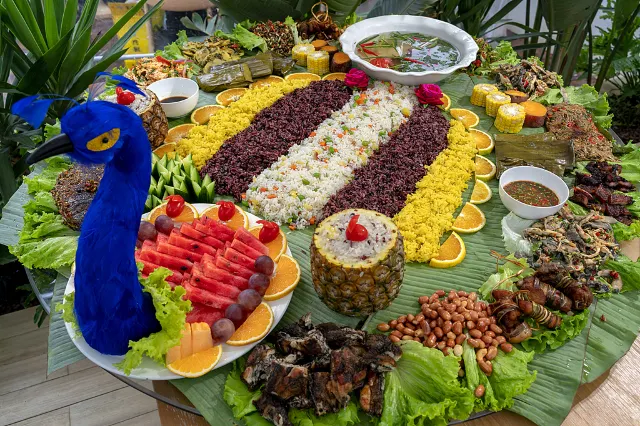
At Jinghong’s Gaozhuang Night Market, you can savor Dai-style barbecue, pineapple rice, and spicy rice noodles, which echo Thailand’s street food classics like som tam and mango sticky rice.
For the adventurous, Dai cuisine offers unique dishes like fried insects and lichen salads, adding an exotic twist to familiar Southeast Asian flavors. This culinary crossover ensures that foodies will find Xishuangbanna’s markets and restaurants as tantalizing as those in Bangkok or Chiang Mai, with the added intrigue of Chinese influences.
Xishuangbanna, China’s tropical gem, is a playground of extraordinary experiences that blend lush rainforests, vibrant Dai culture, and thrilling adventures. There's a kaleidoscope of attractions here that captivate nature lovers, culture enthusiasts, and intrepid explorers alike.
Wild Elephant Valley, nestled in Mengyang Town, 47km north of Jinghong, is Xishuangbanna’s premier destination for encountering China’s last wild Asian elephants, a rare and majestic species. Spanning a lush rainforest, this national park offers a unique blend of wildlife adventure and conservation education, making it a must-visit for nature enthusiasts.
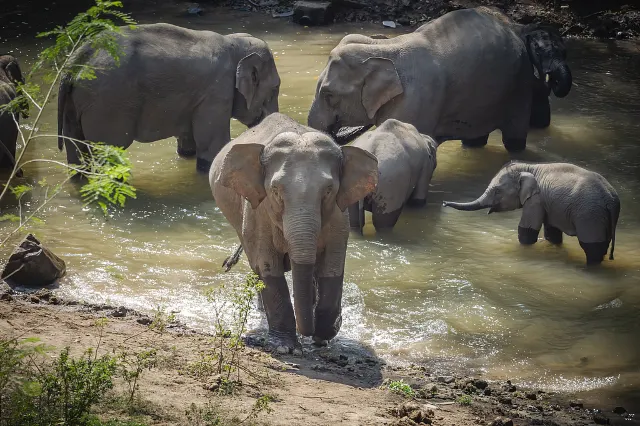
Elevated wooden walkways and a scenic cable car ride offer safe vantage points to spot elephants roaming through the jungle, while the Asian Elephant Museum delves into their biology and conservation challenges.
Though sightings depend on luck—elephants are elusive—visiting early in the morning or late afternoon during the dry season (March–May or September–November) increases your chances.
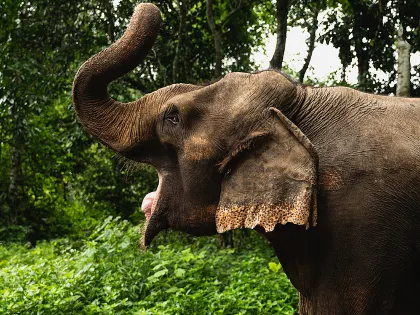
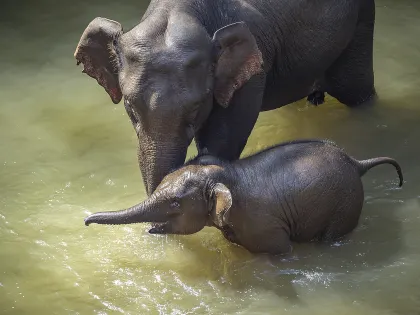
The park’s verdant trails, dotted with tropical flora, also offer a serene escape, immersing you in Xishuangbanna’s biodiversity. Guided tours led by English-speaking naturalists can enhance your experience by providing explanations of elephant behavior and local ecosystems.
Bring binoculars, comfortable walking shoes, and mosquito repellent to fully enjoy this Xishuangbanna attraction, where spotting an elephant in the wild is an unmatched thrill.
The Xishuangbanna Tropical Botanical Garden, located in Menglun, about an hour’s drive east of Jinghong, is a sprawling 900-hectare sanctuary that showcases the region’s title as the “Kingdom of Plants.” Home to over 13,000 plant species, this garden—established in 1959 by renowned botanist Cai Xitao—is one of the world’s leading centers for tropical plant research, making it a paradise for botanists, photographers, and curious travelers.
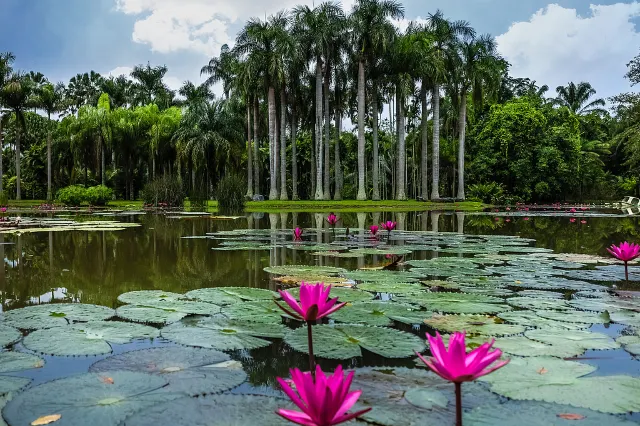
Wander through themed gardens like the Palm Garden, Bamboo Garden, and Orchid Garden, where vibrant blooms and towering trees create a living display of Xishuangbanna’s biodiversity.
Night tours (April–June) offer a magical experience, with fireflies illuminating the paths like tiny stars. Highlights include the rare Dracaena tree and the “dancing grass,” which sways to the sound, adding a whimsical touch.
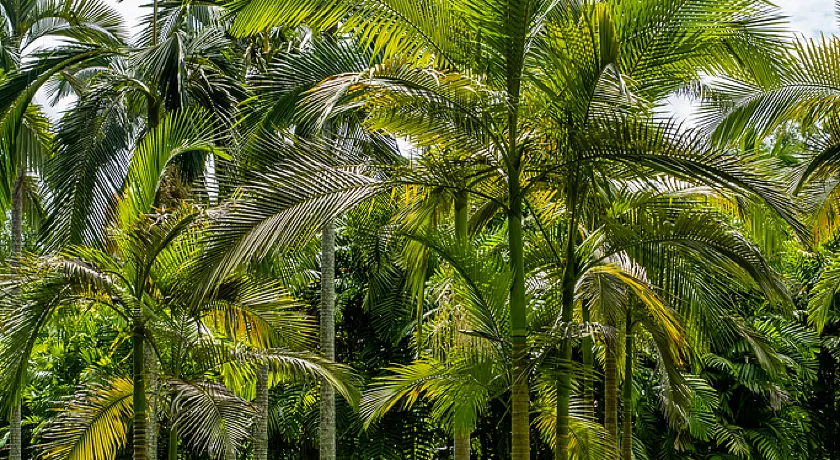
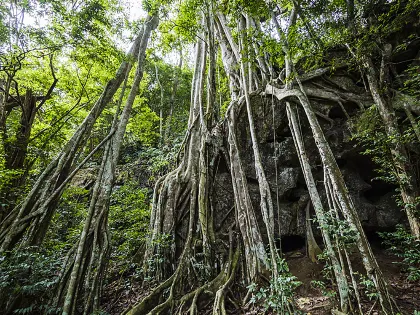
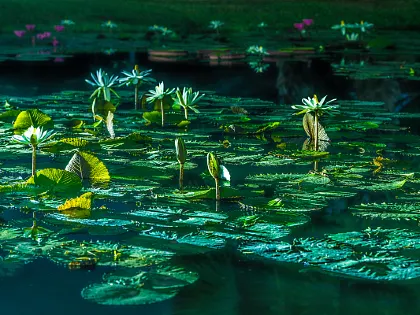
A 3–4-hour visit allows you to explore the garden’s 35 specialized sections, from medicinal plants to tropical fruits. Pack sunscreen, a hat, and a water bottle, and consider a picnic by the garden’s serene lakes to soak in Xishuangbanna’s natural splendor. This attraction is a testament to why Xishuangbanna is a bucket-list destination for nature lovers.
Manting Park, in the heart of Jinghong, is Xishuangbanna’s oldest and most cherished green space, a 1,300-year-old former royal garden that blends history, culture, and tropical beauty. Once a retreat for Dai royalty, this park is a living showcase of Xishuangbanna’s heritage, with serene lakes, swaying palm trees, and ornate Dai-style temples that echo Thailand’s architectural elegance.
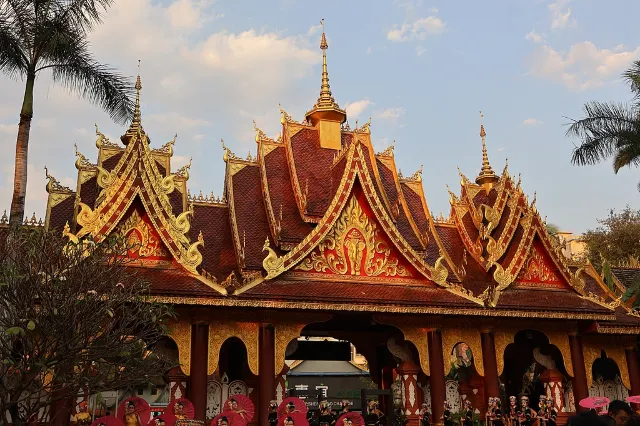
The Wa Ba Jie Temple, with its white stupa and octagonal pavilion, is a highlight, offering a glimpse into the Dai’s Theravada Buddhist traditions. Nightly cultural performances bring the park to life with traditional Dai dances, music, and storytelling, immersing visitors in the region’s vibrant spirit.
Spanning 11 hectares, Manting Park is ideal for a leisurely afternoon stroll, featuring shaded paths and benches that allow you to soak in the ambiance.
Visit in the late afternoon to enjoy cooler temperatures, and stay for the evening show to experience Xishuangbanna’s cultural heartbeat. Bring a camera to capture the temple’s golden details and the park’s lush greenery, making this a quintessential stop on your Xishuangbanna itinerary.
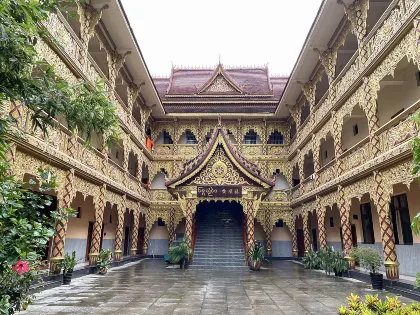
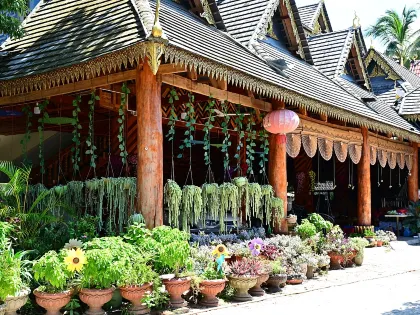
Dai Minority Park, 40 kilometers southeast of Jinghong, is a vibrant celebration of Xishuangbanna’s Dai culture, offering an immersive journey into the traditions of this ethnic group. This sprawling park encompasses five well-preserved Dai villages, where stilted wooden houses, lush gardens, and ornate temples create a living snapshot of daily life.
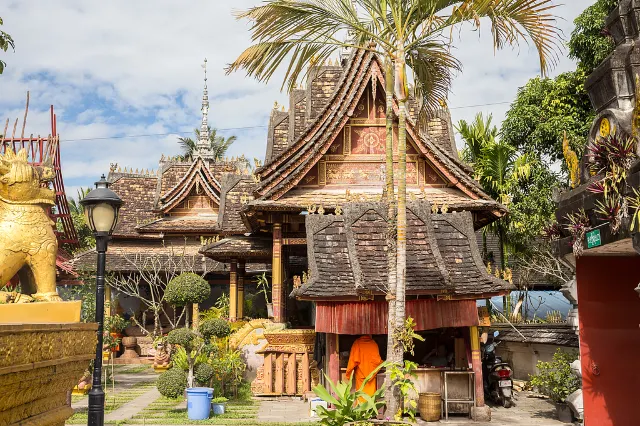
The park’s centerpiece is the Water-Splashing Plaza, where daily reenactments of the famous Water-Splashing Festival bring joyous water fights, music, and dance, letting you experience the Dai New Year’s festive spirit any time of year.
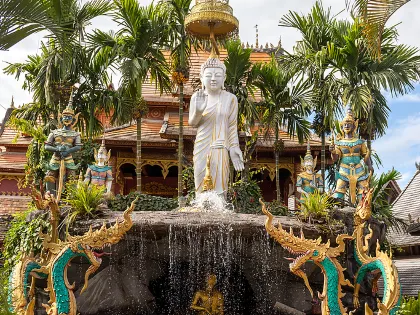
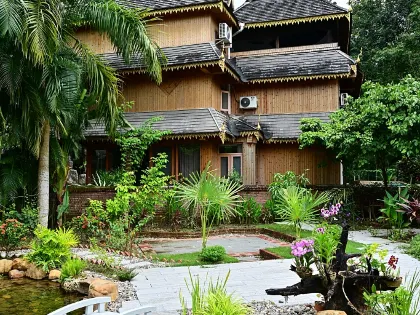
Wander through the villages to see artisans crafting intricate textiles or preparing sticky rice dishes, and visit small temples adorned with naga snake motifs, reflecting the Dai’s Theravada Buddhist heritage. A scenic boat cruise from Jinghong along the Lancang River offers a picturesque way to reach the park, immersing you in Xishuangbanna’s tropical landscapes.
For a deeper cultural dive, join a guided tour to learn about Dai customs, from peacock-inspired dances to nature worship. This a must-visit stop to understand Xishuangbanna’s cultural heartbeat.
Perched on a hill inside Xishuangbanna Mengle Cultural Tourism Area, Mengle Buddhist Temple is Xishuangbanna’s largest and most revered Theravada Buddhist site, a spiritual landmark that echoes the golden grandeur of Thailand’s temples.
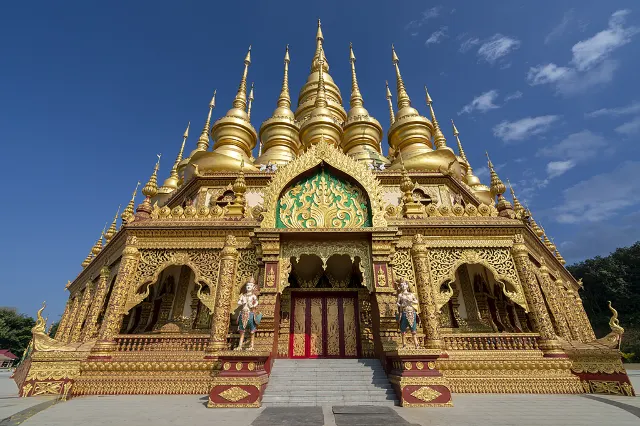
This vast complex, surrounded by tropical gardens, features a towering golden Buddha statue atop a double stairway, offering sweeping views of Jinghong’s palm-lined skyline. The temple’s intricate architecture, featuring gilded spires and colorful murals, reflects the Dai people’s rich Buddhist traditions.
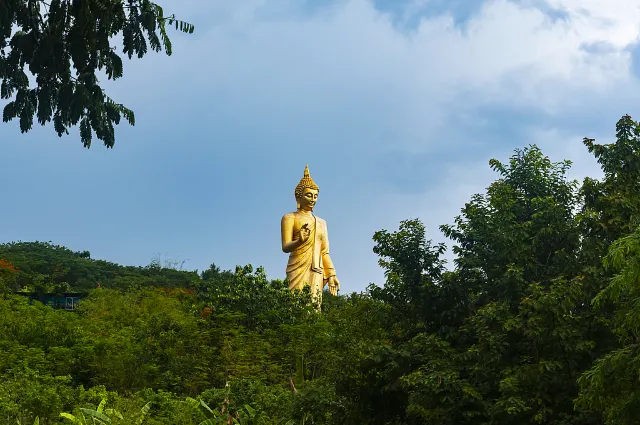
Inside, the Ten Thousand Buddha Stupa and ornate prayer halls invite quiet reflection, while resident monks add an authentic touch to the serene atmosphere. The temple serves as a cultural anchor for the Dai community, hosting ceremonies and festivals that attract locals and visitors alike.
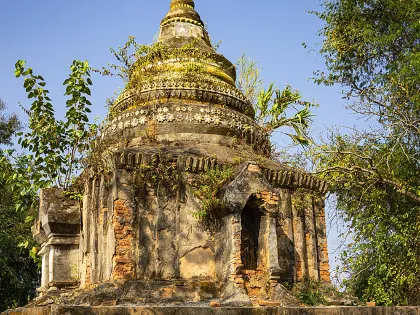
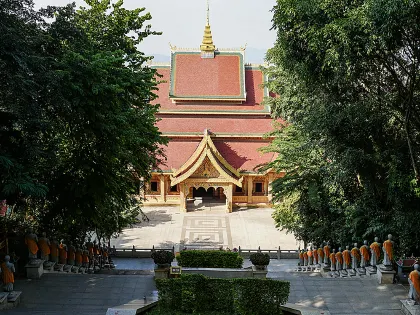
Visit in the early morning to enjoy cooler temperatures and witness monks in their daily rituals, or combine your trip with a stop at nearby Shanding Park to see its Burmese-style pagoda. Bring comfortable shoes for exploring the expansive grounds and a scarf or light cover-up to respect temple etiquette. This Xishuangbanna attraction is a perfect blend of spirituality and scenic beauty, offering a profound glimpse into the region’s heritage.
Gaozhuang Night Market, set along the Lancang River in Jinghong, is Xishuangbanna’s culinary and cultural hub, where the flavors of Dai cuisine come alive under twinkling lights. As night falls, this bustling market transforms into a sensory feast, with hundreds of stalls offering dishes that mirror some of Thailand’s street food scene.
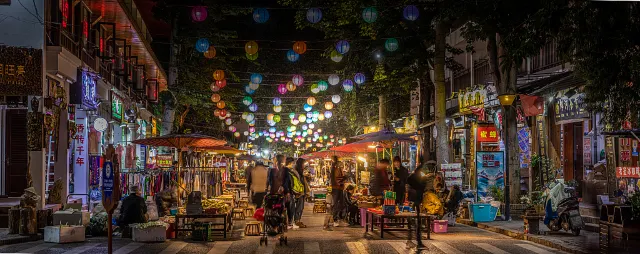
Savor Dai-style barbecue, featuring grilled meats infused with lemongrass and chili, or try pineapple rice served in carved fruit shells, a nod to Southeast Asian flavors. Adventurous eaters can sample unique Dai delicacies, such as fried insects or lichen salads, adding an exotic twist to their culinary journey.
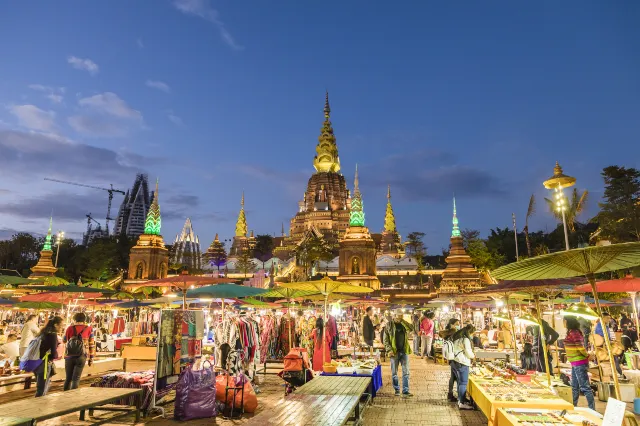
The market’s vibrant atmosphere, with vendors in colorful Dai clothing and live music, makes it more than just a dining spot—it’s a cultural experience. Stroll past stalls selling handmade crafts or try a photo session in traditional Dai attire for a memorable keepsake.
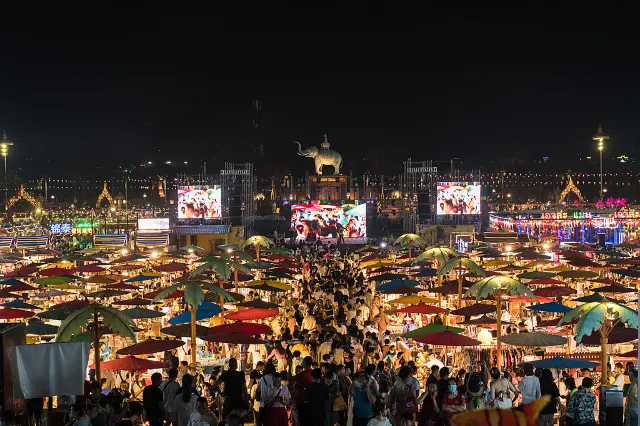
Visit after 6 pm to catch the market at its liveliest, and come hungry to sample a variety of dishes. Bring a reusable tote for souvenirs (cause you will get some) and a sense of adventure to dive into Xishuangbanna’s food scene, where every bite tells a story of the region’s Dai-Thai heritage.
Xishuangbanna’s ancient Dai temples in Jingzhen and Damenglong are living testaments to the region’s rich Theravada Buddhist heritage, offering a serene journey into its cultural soul. In Jingzhen, 30 km west of Jinghong, the Jingzhen Octagonal Pavilion, built in 1701, stands as a striking example of Dai architecture, with its red-and-gold facade and intricate carvings that mirror Thailand’s temple aesthetics.
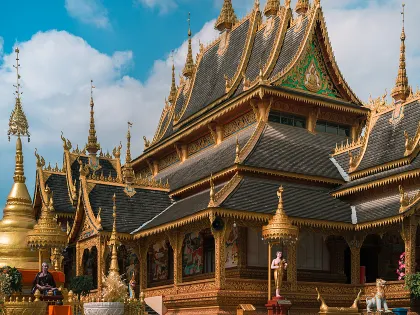
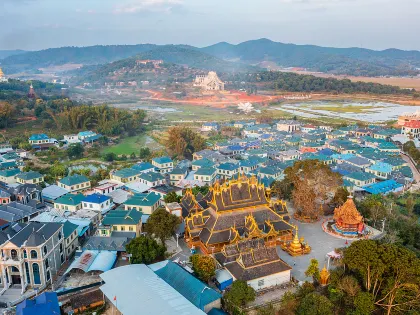
In Damenglong, 70 km south of Jinghong, the White Bamboo Shoot Pagoda (Manfeilong), dating to 1204, captivates with its elegant spire and historical significance, having survived China’s Cultural Revolution. Both temples remain active spiritual sites, where you can observe monks in daily rituals or join locals during Buddhist festivals.
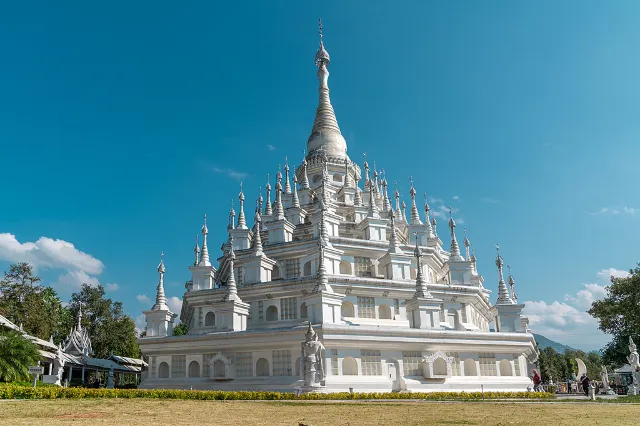
The surrounding villages add charm, with stilted houses and tropical gardens evoking Xishuangbanna’s Southeast Asian vibe. Visit early in the morning to experience the tranquil ambiance and witness chanting ceremonies.
Just 8km east of Jinghong, Xishuangbanna Primeval Forest Park is a 1,700-hectare rainforest oasis that showcases the region’s biodiversity and cultural diversity. This lush park is home to vibrant peacocks, with the daily “Flight of a Thousand Peacocks” show stealing the spotlight as hundreds of birds soar across a serene lake, creating a mesmerizing spectacle.
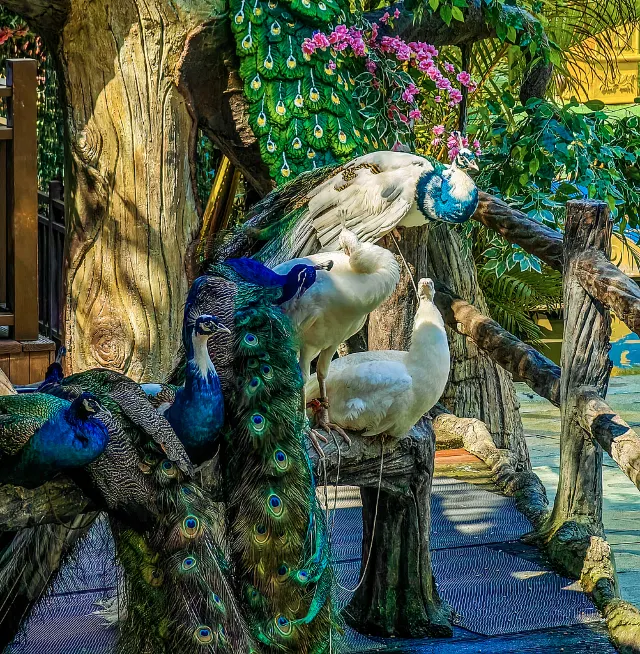
Beyond wildlife, the park features paved trails winding through towering trees and tropical flora, offering a tranquil escape into Xishuangbanna’s natural beauty. The Aini ethnic village within the park offers a glimpse into the traditions of one of Xishuangbanna’s 13 minority groups, providing opportunities to observe traditional crafts and performances.
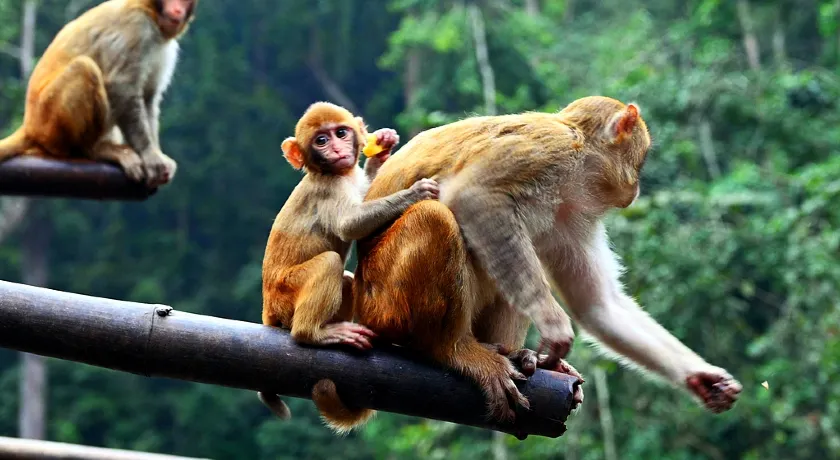
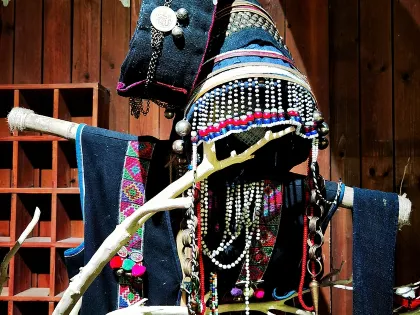
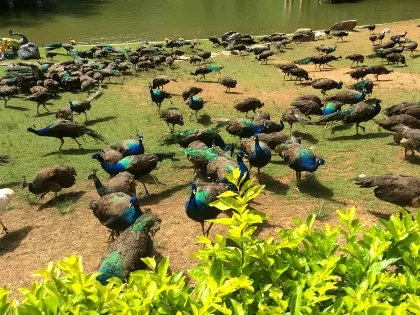
Ideal for families or nature lovers, the park’s compact layout makes it perfect for a half-day visit. Explore in the morning to avoid crowds and catch the peacock show at its scheduled time.
The Wangtianshu Scenic Area in Mengla County, about 60km east of Jinghong, offers an exhilarating adventure through Xishuangbanna’s tropical rainforest via the 2.5km-long Air Corridor. This suspended wooden bridge, soaring 36 meters above the forest floor, connects towering “Sky Trees” that reach up to 80 meters, providing breathtaking views of the canopy and the meandering Nanla River below.
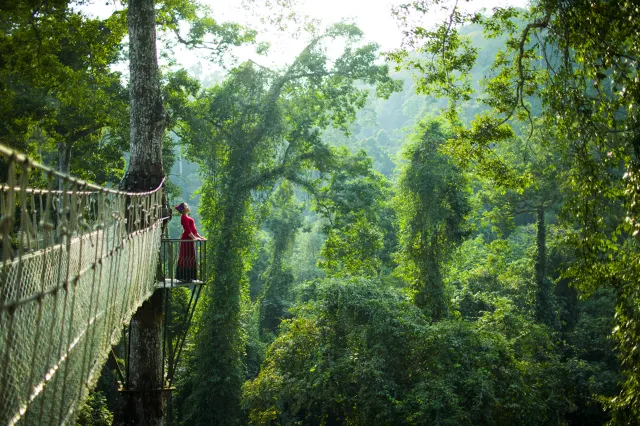
The corridor’s gentle sway adds a thrill, making it a highlight for adventure seekers. Beyond the canopy walk, the area features hiking trails flanked by buttressed trees and lush vegetation, as well as boat rides along the Nanla River for a serene perspective of Xishuangbanna’s wilderness.
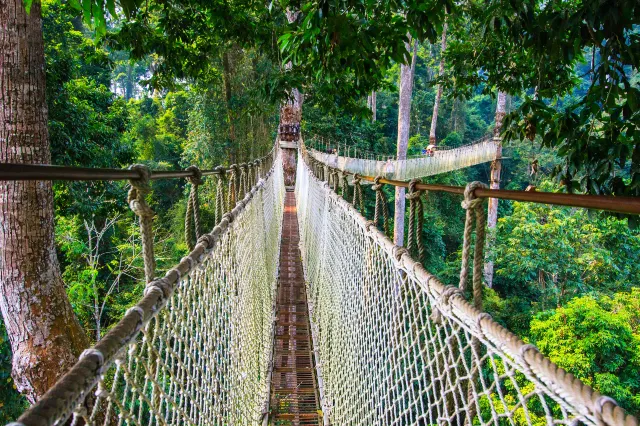
The park’s biodiversity, including rare birds and plants, makes it a haven for photographers and nature enthusiasts. Visit during the dry season (November–April) for optimal weather, and wear sturdy shoes for the bridge and trails. Bring a camera to capture the stunning vistas, ensuring this Xishuangbanna attraction leaves you with unforgettable memories of adventure and natural splendor.
Jingmai Mountain, located 125km west of Jinghong in Lancang Lahu Autonomous County, is a UNESCO World Heritage Site renowned for its ancient tea plantations and cultural significance. This 1,180-hectare region, part of the historic Tea Horse Road, is home to tea trees over 1,000 years old, producing China’s famed Pu’er tea.
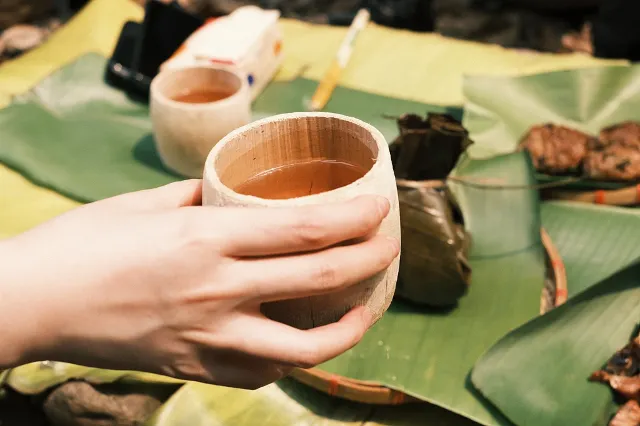
Visiting Jingmai Mountain offers a chance to taste this rich, earthy tea during guided workshops in traditional tea houses, where you’ll learn about its cultivation and brewing techniques. The area’s main village, Jingmai Dazhai, is surrounded by rolling hills and misty tea fields, with the Golden Pagoda serving as a stunning sunrise viewpoint.
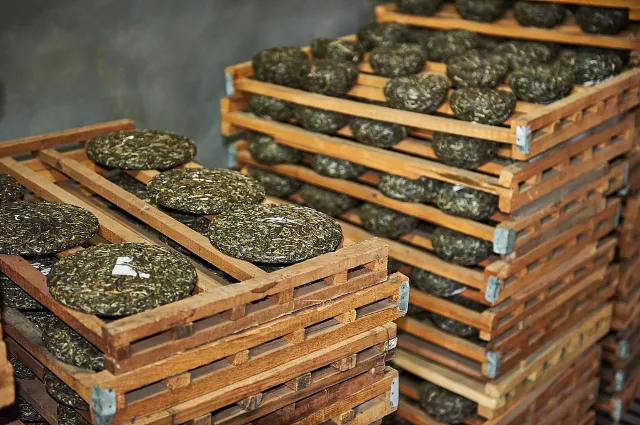
The blend of Dai, Lahu, and Bulang ethnic cultures adds depth, with opportunities to explore traditional villages and local markets. A visit to Jingmai Mountain is a sensory journey into Xishuangbanna’s tea heritage, blending nature, culture, and flavor in a truly unique experience.
The Water-Splashing Festival, held annually in mid-April in Jinghong, is Xishuangbanna’s most vibrant celebration, marking the Dai New Year with a joyous explosion of water fights, music, and cultural pride. This three-day extravaganza transforms the streets into a playful battleground where locals and visitors wield squirt guns, buckets, and hoses to douse each other, symbolizing purification and renewal—a tradition shared with Thailand’s Songkran festival.
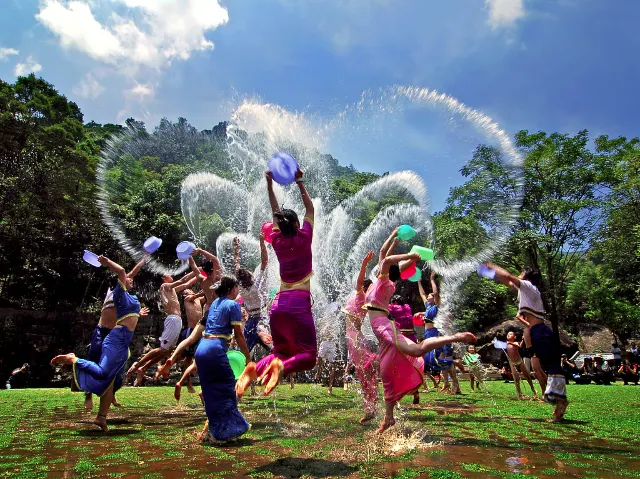
Beyond the water-soaked revelry, the festival features dragon boat races along the Lancang River, where brightly decorated boats glide through cheering crowds, and traditional Dai dances that showcase peacock-inspired grace. Local markets buzz with food stalls offering spicy rice noodles and tropical fruits, adding flavor to the festivities.
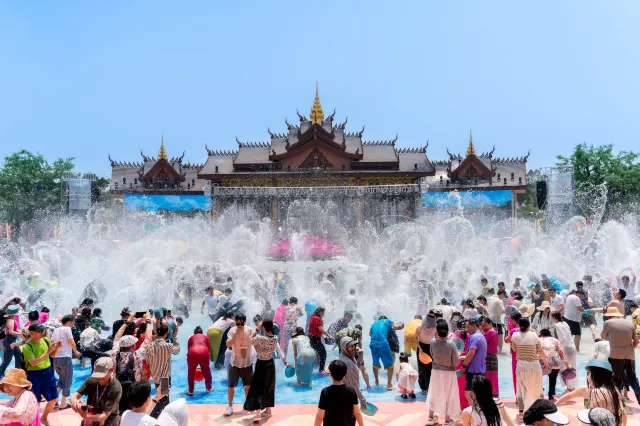
The event’s infectious energy makes it a highlight of Xishuangbanna’s cultural calendar, drawing crowds to experience the Dai’s reverence for water fun and community. Visit during the festival’s peak days for the liveliest atmosphere, and bring a waterproof bag and quick-dry clothing to dive into the fun. This Xishuangbanna tradition is a must for anyone seeking an immersive cultural adventure.
Scattered around Jinghong and Mengla, the Hani and Jinuo ethnic villages offer a captivating glimpse into Xishuangbanna’s diverse cultural mosaic, beyond the dominant Dai heritage. The Hani, known for their terraced rice fields and intricate weaving, welcome visitors into their stilted homes to share stories of their nature-centric traditions.
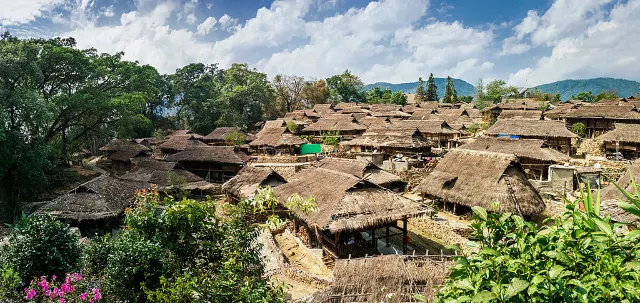
The Jinuo, one of Xishuangbanna’s smaller ethnic groups, are renowned for their vibrant festivals, like the cattle slaughtering ceremony, which celebrates community and harvest. These villages, nestled amid tropical greenery, feature traditional crafts, such as handmade textiles and bamboo carvings, and offer opportunities to witness local dances or sample homemade rice wine.
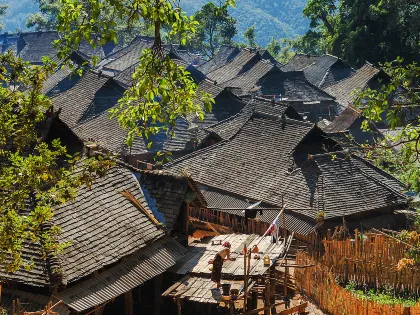
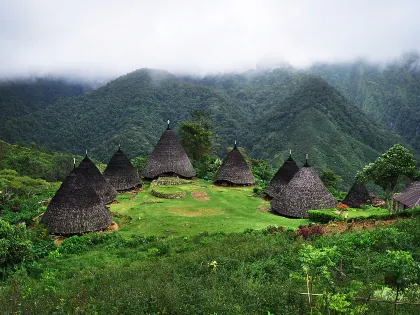
Visiting these communities feels like stepping into a living museum, where ancient customs thrive alongside Xishuangbanna’s modern pulse. Opt for a morning visit to catch daily activities like weaving or cooking, and consider hiring a local guide to deepen your understanding of Hani and Jinuo traditions.
A Dai cultural show in Jinghong is a mesmerizing window into Xishuangbanna’s artistic heritage, bringing the Dai people’s traditions to life through dance, music, and storytelling. Held at various venues, including Manting Park and local theaters, these evening performances feature performers in vibrant silk costumes executing peacock-inspired dances, a nod to the Dai’s reverence for this sacred bird.
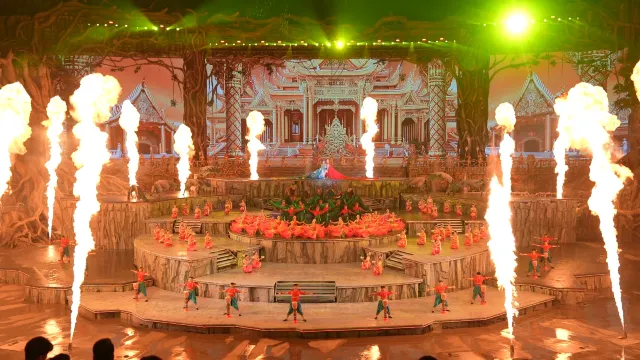
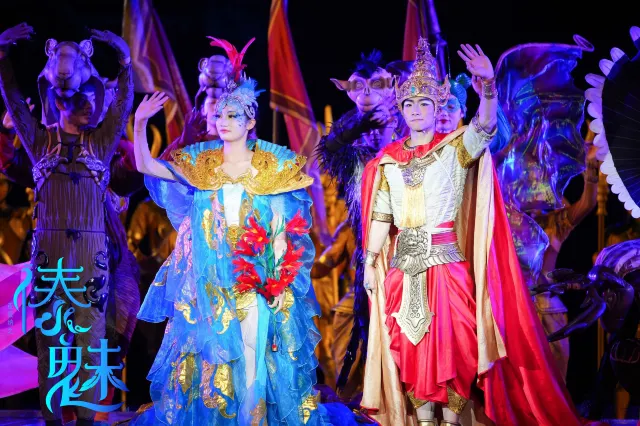
Accompanied by traditional instruments like the hulusi (a gourd flute), the shows weave tales of Dai folklore, ranging from mythical love stories to celebrations of nature. The choreography, with its fluid movements and intricate patterns, mirrors the elegance of Thai classical dance. Some performances include interactive elements, inviting visitors to try basic dance steps or sample Dai snacks.
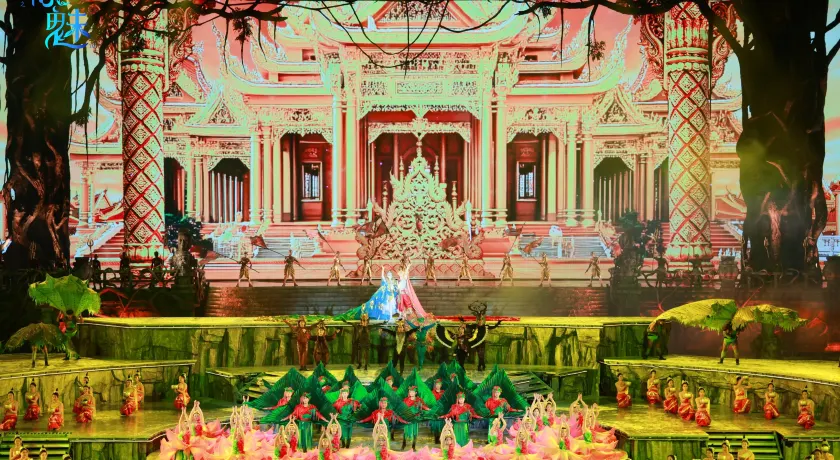
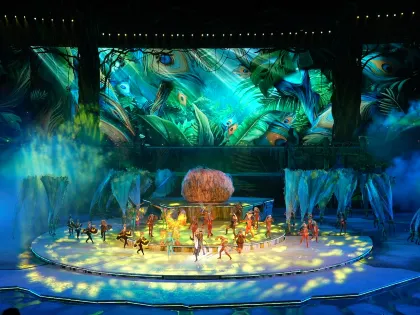
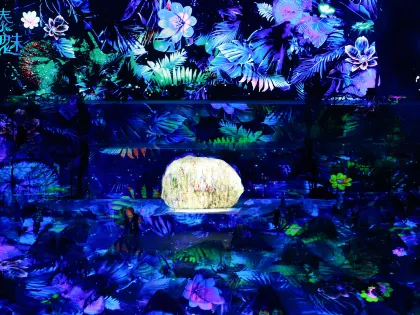
These evening shows are a perfect way to experience Xishuangbanna’s cultural vibrancy after a day of exploring.
Cycling through the rural trails of Mengla County, about 60 km east of Jinghong, is an offbeat adventure that unveils Xishuangbanna’s untouched landscapes and traditional village life. These scenic routes wind through emerald rice paddies, banana groves, and Dai villages, where stilted houses and friendly locals create a serene, authentic atmosphere.
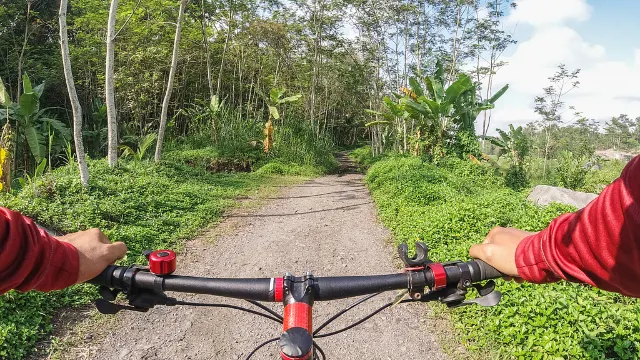
Guided bike tours lead you to hidden gems like small waterfalls, rural markets, or ancient banyan trees, offering a sustainable way to explore Xishuangbanna’s tropical heart. The trails range from easy, flat paths for casual riders to more challenging routes for seasoned cyclists, with stunning views of rolling hills and jungle canopies.
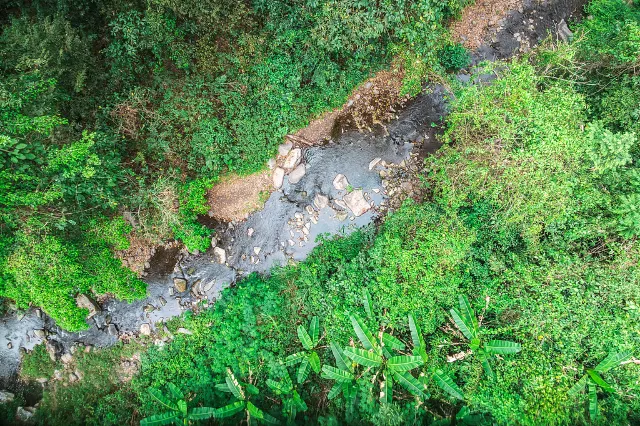
This activity, less touristy than Xishuangbanna’s major attractions, provides a personal connection to the region’s rural charm.
Kayaking or rafting on the Lancang River, known globally as the Mekong, is an exhilarating way to experience Xishuangbanna’s tropical landscapes from the water. Flowing through Jinghong, this mighty river carves a scenic path lined with palm trees, rice paddies, and Dai villages, offering a serene yet adventurous perspective of the region’s natural beauty.
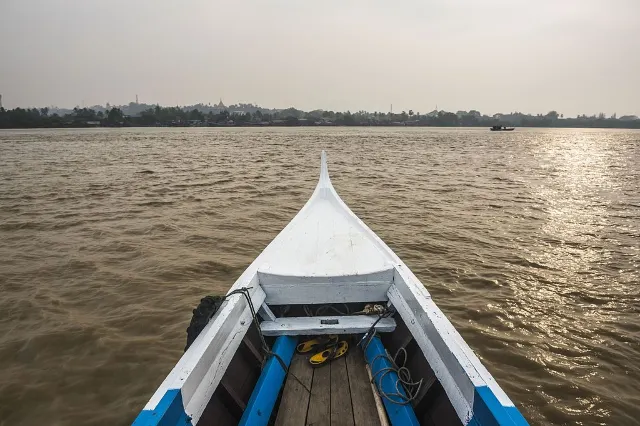
Local operators offer guided kayaking trips for beginners, gliding past lush riverbanks, or thrilling white-water rafting for adrenaline junkies, particularly in the wet season (May–October) when the river swells. Along the way, you might spot water birds or glimpse traditional fishing boats, connecting you to Xishuangbanna’s vibrant ecosystem.
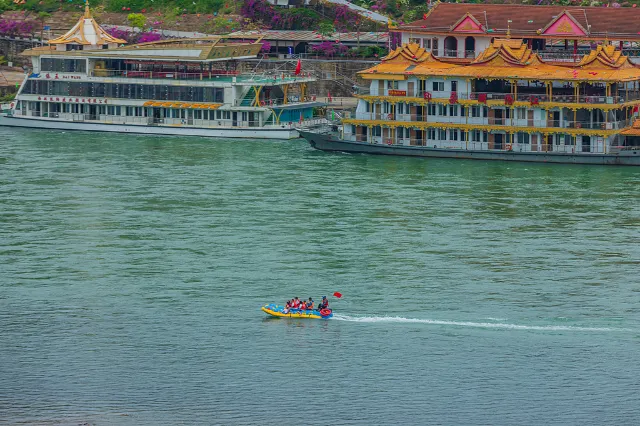
The river’s cultural significance, shared with Thailand and Laos, adds depth, as it serves as a lifeline for local communities. This Xishuangbanna adventure blends nature and excitement, making it a perfect addition to your itinerary.
Jinghong’s Tropical Flower & Plants Garden, located on the western edge of the city, is a verdant sanctuary showcasing Xishuangbanna’s title as the “Kingdom of Plants.” Spanning lush grounds, this garden features over 1,000 plant species, from vibrant orchids and hibiscus to rare medicinal herbs, arranged in themed sections connected by winding stone paths.
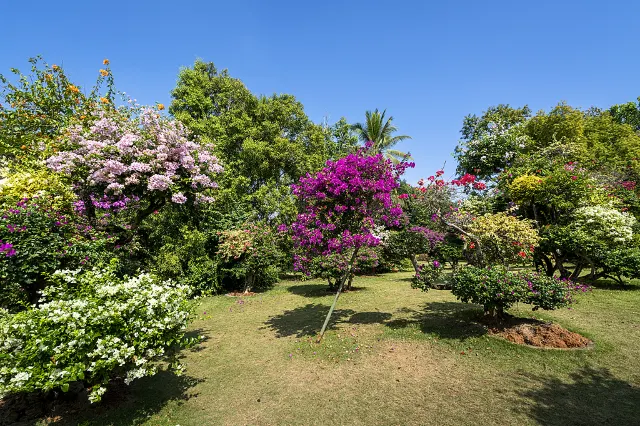
Established as a botanical haven, it offers a tranquil escape where you can marvel at tropical blooms and towering palms that evoke the lush landscapes of Southeast Asia. Highlights include the butterfly garden, where colorful insects flit among the flowers, and the shade garden, home to ferns and mosses that thrive in Xishuangbanna’s humid climate. The garden’s serene ponds and shaded benches make it ideal for a leisurely stroll or quiet reflection.
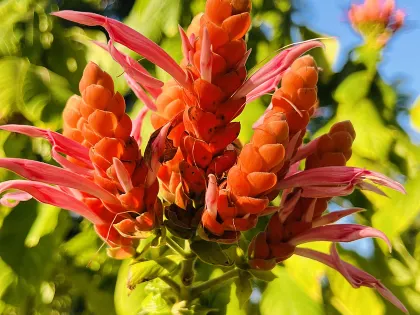
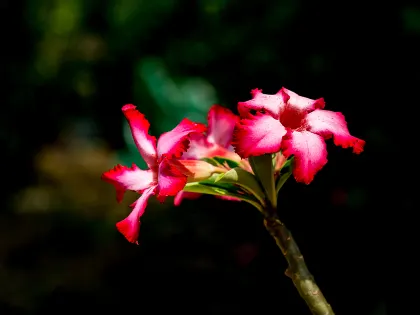
Embarking on a cross-border train journey from Jinghong to Vientiane, Laos, via the China-Laos high-speed railway is a thrilling way to extend your Xishuangbanna adventure into Southeast Asia. Departing from Xishuangbanna’s Boten station, trains cover the 414km route in about nine hours, passing through lush jungles, dramatic karst mountains, and the Mekong River valley.
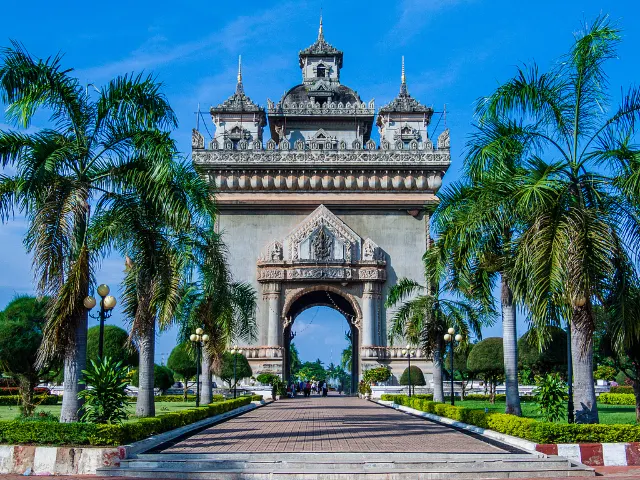
This modern railway offers comfortable seating and panoramic windows, allowing you to soak in the stunning scenery that seamlessly links Xishuangbanna’s tropical vibe with Laos’ laid-back charm. The journey is a cultural bridge, connecting the Dai of Xishuangbanna with their Tai cousins in Laos, with stops like Luang Prabang offering a taste of shared heritage.
Morning departures provide the best daylight views, so book an early train to maximize the experience. Bring a valid passport, a pre-arranged Lao e-visa, and a camera to capture the cross-border landscapes.
Jinuo Mountain, located in Jinuo Township, about 30km from Jinghong, offers an immersive rainforest hiking experience that blends Xishuangbanna’s natural splendor with the rich culture of the Jinuo people, one of China’s smallest ethnic groups.
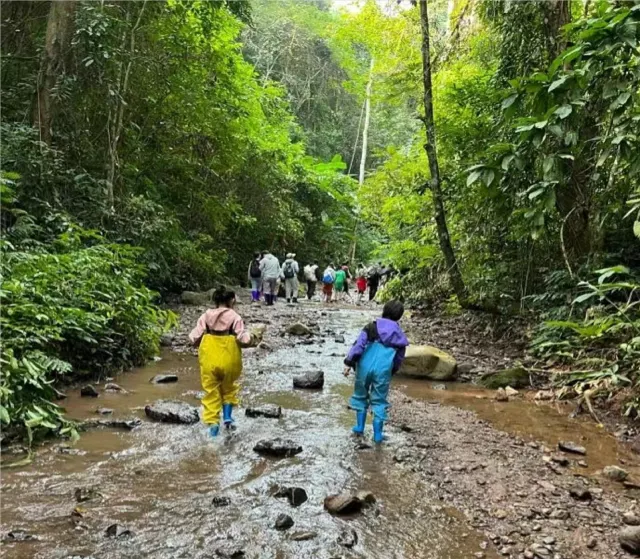
The trails, winding through dense tropical forests, showcase towering strangler figs, buttress roots, and vibrant birdlife, immersing you in Xishuangbanna’s biodiverse heart. Starting from Bapo Village, guided hikes (4km short or 8km challenging routes) include unique activities such as jungle swings, stream trekking, and rainforest picnics featuring local bananas and bamboo-cooked rice.
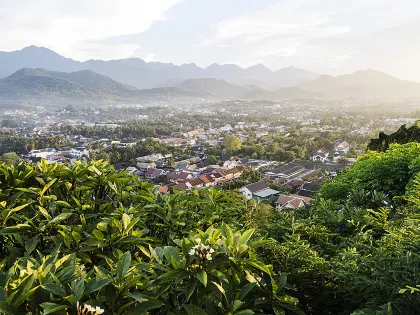
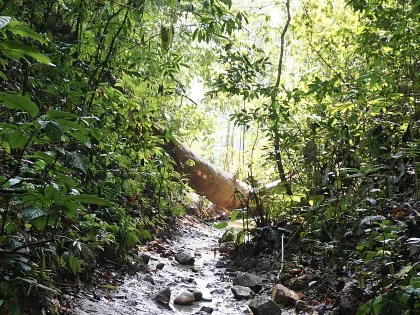
Along the way, visit cultural landmarks like the Jinuo Big Drum Gate or the statue of goddess Amoyaobei, and learn about the Jinuo’s matriarchal heritage and tea traditions. The dry season (November–April) is ideal for hiking, with cooler weather and safer trails.
Soaring above the Xishuangbanna Tropical Botanical Garden in Menglun, about an hour east of Jinghong, a hot air balloon flight offers a breathtaking aerial perspective of Xishuangbanna’s “Kingdom of Plants.” This 900-hectare sanctuary, home to over 13,000 plant species, transforms into a vibrant patchwork of green canopies, winding rivers, and colorful gardens from above.
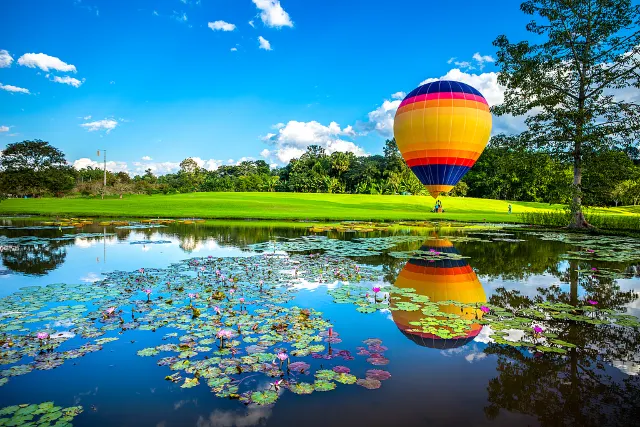
The balloon ride, typically offered during calm early mornings, provides stunning views of the Palm, Bamboo, and Orchid Gardens, with the Luosuo River glinting in the distance. As you float silently over the rainforest, you might spot rare birds or the misty outlines of Mengla’s hills, adding a magical touch to your Xishuangbanna journey.
Bai Xiang Beach Park, nestled along the banks of the Lancang River in Jinghong, is Xishuangbanna’s unexpected tropical beach escape, offering a serene spot to unwind amid the region’s lush landscapes. This man-made beach, fringed by swaying palm trees and soft, golden sand, captures the Southeast Asian charm that defines Xishuangbanna, making it a perfect place to relax or stroll with a river breeze.
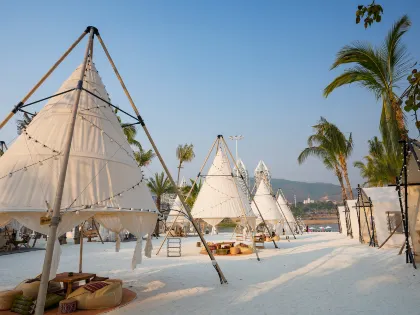

The park’s tranquil setting is ideal for picnics, kite-flying, or simply soaking in views of the river and distant jungle hills, with occasional boats gliding by adding to the scenic allure. Local families gather here to enjoy the laid-back vibe, often playing games or savoring Dai snacks from nearby vendors.
Here are a few key tips that can make your journey to Xishuangbanna seamless and unforgettable.
The best time to visit Xishuangbanna is during the dry season, from November to April, when the weather is mild and sunny, with average winter temperatures around 22°C.
This period offers comfortable conditions for exploring attractions like the Tropical Botanical Garden or hiking Jinuo Mountain, with clear skies enhancing scenic views.
April is particularly special, as it coincides with the Water-Splashing Festival, a vibrant celebration of the Dai New Year featuring water fights and dragon boat races.
The wet season (May–October) brings lush greenery but frequent rain, which can make trails slippery and outdoor activities challenging. Pack lightweight, breathable clothing for the warm climate, along with a waterproof jacket for unexpected showers.
Mosquito repellent is essential year-round, especially in rainforest areas like Wild Elephant Valley, to ensure a comfortable Xishuangbanna adventure.
Navigating Xishuangbanna is straightforward, with a variety of transportation options to suit different travel styles. In Jinghong, the region’s main hub, taxis are readily available and convenient for short trips to attractions like Manting Park or Gaozhuang Night Market.
Ride-hailing apps like Didi streamline bookings, providing a hassle-free way to navigate the city.
Public buses, particularly routes 4 and 7, connect key locations in Jinghong, such as the Mengle Buddhist Temple and the Tropical Flower & Plant Garden, making them an affordable choice for budget-conscious travelers.
For exploring nearby areas like the Dai Minority Park in Ganlanba, consider a scenic boat cruise along the Lancang River.
To reach remote destinations like Jingmai Mountain or Mengla’s Wangtianshu Canopy, hiring a car through local agencies or online provides flexibility and comfort.
For an active adventure, rent a bicycle in Jinghong or Mengla to pedal through rural trails, soaking in Xishuangbanna’s tropical landscapes.
Xishuangbanna is more than a destination—it’s a vibrant combination of tropical jungles, Dai traditions, and Southeast Asian flair, earning its title as “China’s mini Thailand.” From spotting wild elephants in lush rainforests to joining the joyous chaos of the Water-Splashing Festival, this southern Yunnan gem offers a kaleidoscope of experiences that captivate every traveler.
Pack your sense of wonder, a camera for unforgettable moments, and an appetite for exploration. Xishuangbanna awaits to sweep you into its tropical embrace—start crafting your itinerary today and discover why this paradise belongs on your travel list.
Trending Travelogues
Popular Ranked Lists
Recommended Attractions at Popular Destinations
About





of the year 2024
Site Operator: Trip.com Travel Singapore Pte. Ltd.


